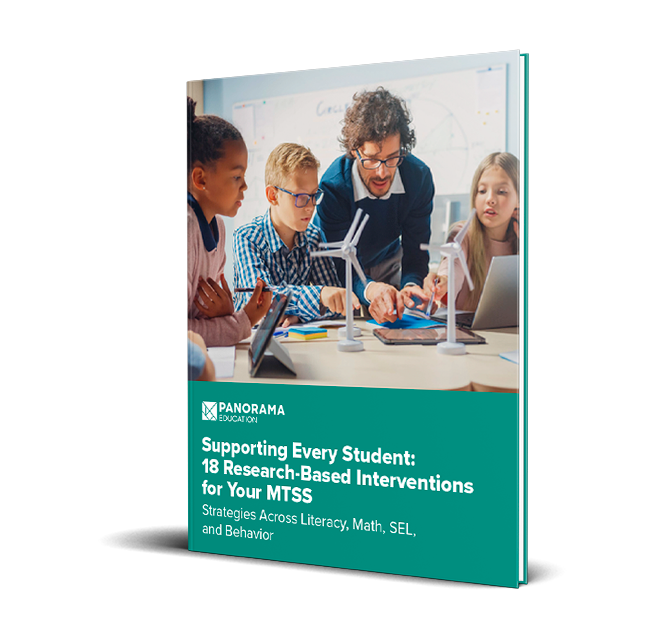When districts prioritize and fortify Tier 1 instruction, they see enhanced academic outcomes across the board. This robust foundation acts as a catalyst, driving collective achievement and ensuring that every student receives a quality education tailored to their needs.
While a strong Tier 1 foundation is key, districts may find it challenging to translate their vision into tangible classroom practices. Join us as we delve deeper into Tier 1 instruction, exploring strategies and insights to cultivate the universal support students so rightfully deserve.
What is Tier 1 Instruction?
Tier 1 instruction, often termed universal support, encompasses the foundational teaching and learning strategies provided to all learners. When building a tiered intervention menu, Tier 1—as it’s aptly named—is the very first level of student support. In essence, Tier 1 instruction forms the initial, critical layer of intervention, and is pivotal in laying the groundwork for subsequent tiers of support.
A comprehensive approach to Tier 1 instructional strategies addresses more than just academics. It delves into the behavioral and social-emotional facets of a student's life. In turn, this foundation allows districts to adopt a proactive stance, anticipating potential challenges and equipping educators with the tools and strategies to foster a positive learning environment for all.
Benefits of a Strong Tier 1 Foundation
Effective Tier 1 instruction is a game-changer for educators and leaders. It simplifies lesson planning, offering a structured approach that enhances teaching consistency. Beyond this, it ensures that every student receives consistent foundational support, setting them up for success in more advanced concepts and skills.
Streamline Lesson Planning
Tier 1 instruction offers educators a structured roadmap, making the lesson planning process more efficient and purposeful. Teachers can rely on the foundational principles of Tier 1 to craft comprehensive and inclusive lessons. This structured approach ensures that core content is effectively delivered to all students. By having a clear Tier 1 framework, educators can allocate their time more strategically, focusing on enhancing the quality of instruction rather than constantly reinventing the planning wheel.
Individualizing Student Support
A strong Tier 1 foundation empowers educators to more readily identify students who may require additional assistance or enrichment. When the foundational needs of the majority are met through Tier 1 strategies, teachers can allocate resources and interventions more effectively for those students who need specialized attention. This proactive approach not only enhances the learning experience but also creates a more responsive environment where individual student needs are recognized and addressed promptly.
Supporting Staff Efficiency
A solid Tier 1 foundation is not just for the classroom; it has a ripple effect throughout the entire school system. By establishing a strong foundational framework for all students, Tier 1:
- Reduces the influx of preventable challenges or gaps that might otherwise strain support resources.
- Allows support staff to operate within clearer parameters, focusing their expertise on targeted interventions rather than widespread remediation.
- Streamlines and simplifies administrative tasks through making decision-making more informed and effective
- Supports allocation of resources where they are needed most to optimize outcomes for both educators and students.
- Ensures that every member of the educational community, from educators to specialized support personnel, can work collaboratively and efficiently, maximizing the impact of their efforts across the board.
Collective Benefits for the Educational Community
Schools with well-established Tier 1 practices foster a positive school climate, promoting collaboration and mutual support among educators, students, and the broader community. This positive environment has a strong positive impact. As workload pressures diminish, educators can focus more on innovative teaching, leading to improved student outcomes and, in turn, further enhancing the school's positive atmosphere.
Strengthening Tier 1 Instruction Across Districts
Navigating the intricacies of Tier 1 instruction requires a multifaceted approach that acknowledges the diverse needs of students and the evolving landscape of education. To establish this foundational level of instruction across a district, several strategies emerge as particularly impactful.
- Differentiated Instruction Techniques
By offering varied approaches within the same lesson, educators can ensure that all students—regardless of their starting point—can grasp and apply concepts effectively. - Professional Development Programs
Regular training sessions, workshops, and seminars not only keep teachers updated with the latest in pedagogical strategies, but also equip them with tools to adapt and innovate in the classroom. - Data-Driven Decision Making
Utilizing real-time student data and regularly analyzing assessment results empowers educators to make informed instructional decisions, ensuring that Tier 1 instruction remains relevant and impactful. - Collaborative Teaching Practices
Building a culture of collaboration among educators promotes a sharing of best practices. When teachers work together, they can pool resources, brainstorm solutions to challenges, and create a unified approach to instruction that benefits all students. - Integration of Technology
By using an MTSS platform, educators can better understand when a student needs more support. With this insight, educators can determine ways to engage students in more personalized and relevant ways. - Family and Community Involvement
By fostering strong partnerships with parents and local stakeholders, schools can create a cohesive support system for students, ensuring consistent learning opportunities both inside and outside the classroom.
Examples of Tier 1 Instruction
Tier 1 instruction strategies not only simplify the complexities of teaching, but also lay the groundwork for a more enriched and supportive educational environment. Let's explore the real-world applications of Tier 1 instruction, illustrating how these practices can bring about meaningful change in classrooms and communities alike.
Writing Instruction
Writing stands as a foundational pillar of Tier 1 instruction, yet it frequently contends with reading for instructional focus. While reading often takes precedence due to standardized testing priorities, writing remains vital across all subjects.
Educators seeking to bolster their Tier 1 instruction should consider implementing writing strategies that not only enhance writing skills, but also enrich the broader instructional landscape. Some of these can be:
- Paragraph Burger
A widely recognized writing intervention strategy, the Paragraph Burger serves as a tangible tool for students across all grade levels and genres. This visual graphic organizer not only simplifies but also enriches the planning phase of writing. By breaking down the structure of a paragraph into its core components, students can visualize the relationship between topic sentences, supporting details, and concluding statements, ensuring a well-rounded composition. - Four-Square
The Four-Square method simplifies the intricacies of planning and organization in writing. This straightforward graphic organizer provides students with a structured framework, helping them categorize ideas, sequence thoughts, and maintain coherence throughout their writing. Whether crafting a narrative or an argumentative piece, the Four-Square method acts as a reliable guide, ensuring clarity and purpose in student compositions. - Mentor Texts
Beyond structural aids, the influence of exemplary writing is paramount. Mentor Texts, which encompass a range of published works, serve as goldmines of inspiration and instruction. By immersing themselves in published writing, students gain exposure to diverse writing styles, techniques, and tones. Through observation, rereading, and detailed analysis, students not only appreciate the artistry of proficient writing but also internalize strategies that they can adeptly incorporate into their own creations.
Read More: 5 Research-Based Writing Interventions for Your MTSS
Behavior Interventions
In response to rising behavioral challenges intensified by recent events, schools are increasingly turning to a Positive Behavioral Interventions and Supports (PBIS) framework.
Embedded within your MTSS, PBIS offers tiered behavioral strategies, emphasizing both preventative measures and responsive supports, thereby contributing significantly to cultivating positive school environments and enhancing student outcomes.
Tier 1 PBIS interventions set the foundation for an entire school or district. These interventions focus on setting clear expectations for behaviors, and implementing procedures and practices for teaching the emotional and social skills needed for positive behavior.
Here are some PBIS Interventions to consider:
- Behavior-Specific Praise
Behavior-specific praise goes beyond generic commendations by pinpointing and acknowledging specific positive behaviors observed in students. This tailored approach, backed by nearly three decades of research, not only reinforces classroom expectations but also fosters a clearer understanding of desired behaviors.
By highlighting the particular behavior, identifying the student or group involved, and delivering the praise with genuine warmth, educators can effectively encourage more consistent positive actions, making it a pivotal tool for managing classroom dynamics and enhancing overall academic success. - Visual Aids
Visual aids are invaluable tools in the classroom, offering consistent cues that guide students through daily routines and expectations. By leveraging these aids, educators empower students to take charge of their responsibilities and reduce dependency on constant teacher guidance.
They encompass tools like visual timers that help students grasp time durations, visual schedules that outline daily plans with clarity, and reminders, such as supply visuals or behavior posters, ensuring students maintain positive habits and stay organized. - Brain Breaks
Essential pauses that refresh both the mind and body, brain breaks help enhance focus and productivity in learning environments. They can range from physical activities like short exercises or walks, to mental diversions such as puzzles or breathing exercises.
Effective brain breaks fully engage students, ensuring a complete shift from prior activities, which is particularly vital during distressing moments. Activities like crosswords or dance videos can effectively redirect students' attention, preventing them from dwelling on issues and ensuring a rejuvenated return to learning.
Download Now: 20 Evidence-Based Behavior Interventions: A Toolkit for District Leaders
Social-Emotional Learning (SEL)
Social-Emotional Learning (SEL) equips students with vital skills to manage emotions, set positive goals, and establish healthy relationships. By aligning Tier 1 methodologies to SEL interventions, educators can create an environment where academic success and emotional well-being are seamlessly intertwined. This ensures that students are not only academically proficient, but also emotionally equipped for future challenges. Some of these strategies include:
- Rose, Bud, Thorn
This activity encourages students to reflect on their day by identifying a positive aspect (rose), something they're looking forward to (bud), and a challenge they faced (thorn). It fosters self-awareness and helps educators gauge students' emotional states.
Free Download: Panorama’s Rose, Bud, Thorn Activity Worksheet - Two Word Check-In
Students express their current feelings or thoughts using just two words. This concise activity prompts students to distill their emotions, making it easier for educators to quickly understand and address their needs. - WOOP Method
An acronym for Wish, Outcome, Obstacle, Plan, the WOOP method is a goal-setting strategy. Students identify a wish, visualize a positive outcome, anticipate obstacles, and devise a plan. It combines positive thinking with proactive planning, enhancing both motivation and resilience.
Learn More: 15 Social-Emotional Learning Intervention Ideas for School and District Teams
Attendance Interventions
By ensuring students are regularly in the classroom, we pave the way for them to fully benefit from foundational lessons. In essence, by addressing attendance proactively, we're fortifying the very foundation of Tier 1, reinforcing its impact and reach within our educational settings. To support stronger attendance, school and district leaders can consider:
- Establishing a Positive School Culture
Cultivating a nurturing and inclusive school environment plays a pivotal role in promoting regular attendance. When students feel valued, connected, and engaged within their school community, they are more motivated to attend regularly and participate actively in classroom activities. - Communication and Engagement with Parents
Open lines of communication between schools and families are crucial. By regularly updating parents on attendance records, sharing the importance of consistent school attendance, and seeking their collaboration in addressing any underlying issues, schools can foster a supportive home-school partnership that encourages regular attendance. - Celebrating Attendance Milestones
Recognizing and celebrating attendance achievements can be a powerful motivator for students. Whether it's acknowledging monthly perfect attendance, hosting quarterly attendance celebrations, or rewarding classes with the best attendance rates, these initiatives can instill a sense of pride and commitment among students towards attending school consistently. - Early Intervention and Support Systems
Proactively identifying students who may be at risk of chronic absenteeism and implementing targeted support can make a significant difference. By understanding and addressing the root causes of absenteeism, such as health issues, transportation challenges, or disengagement, schools can provide the necessary resources and interventions to ensure that students are present and engaged in their learning.
Free Toolkit for District Leaders: Decreasing Absenteeism
Next Steps for School and District Leaders: Strengthening Tier 1 Instruction
At the heart of education lies the belief that every student deserves the best. While the aspiration for high-quality Tier 1 instruction across social-emotional learning, behavior, and academics is universal, districts face a range of implementation challenges.
As you reflect on your district's approach, consider implementing some of the strategies we’ve discussed. Additionally, an MTSS platform like Panorama Student Success can ensure consistent support across every tier—in academics, behavior, social-emotional learning, and attendance. These strategies and tools ensure that universal supports are not just present but are robust, effective, and truly transformative for every student.







